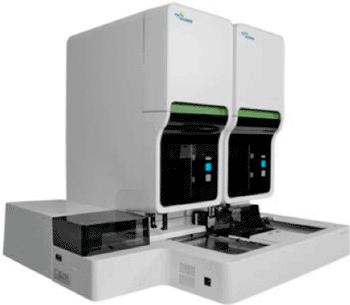Automated Hematology Analyzer Enumerates Peripheral Blood Stem Cells
By LabMedica International staff writers
Posted on 15 Jan 2014
The number of infused cluster of differentiation CD34+ cells, which are normally found in the umbilical cord and bone marrow as hematopoietic cells, is crucial to the success of peripheral blood stem-cell transplantation (PBSCT). Posted on 15 Jan 2014
Although the ability to count CD34+ cells currently depends solely on flow cytometric analysis, the complexity of the procedure and cost of reagents, including monoclonal antibodies, are major disadvantages, which can be overcome using an automated hematology analyzer.

Image: The XN-2000 series model automated hematology analyzer (Photo courtesy of Sysmex).
Scientists at the National Cancer Center Hospital (Tokyo, Japan) have introduced a novel method based on hemolysis and chemical staining, followed by flow cytometry-based optical detection, and conducted using an automated hematology analyzer. Cells expressing the CD34+ and hematopoietic progenitor cells (HPCs) were compared in 76 granulocyte colony-stimulating factor (G-CSF)-mobilized blood or apheresis samples taken from 18 healthy donors and 6 patients undergoing autologous PBSCT.
The newly launched XN-series model automated hematology analyzer (Sysmex Corporation; Kobe, Japan) was used to measure the HPCs. The XN-series model is equipped with a white precursor cell (WPC) channel to detect immature cells, such as myeloblasts and abnormal lymphocytes. The measuring principle of this channel utilizes the optical detection system and general flow cytometry. In this channel, two reagents are used: the lysis reagent containing a polyoxyethylene nonionic surfactant and the stain reagent containing a polymethine dye. CD34+ cells were isolated using MACS magnetic cell separation kits (Miltenyi Biotec; Bergisch Gladbach, Germany).
The investigators found a strong correlation between the numbers of HPCs and CD34+ cells. The expected total number of HPCs in the final products, which was estimated from HPCs in preapheresis peripheral blood (PB) or midapheresis products, also correlated well with the total number of CD34+ cells in the final products. The change in HPCs in PB closely resembled that of CD34+ cells during mobilization. Studies using immunomagnetic beads suggested that the majority of CD34+ cells existed in HPCs, and vice versa.
The authors concluded that their novel HPC enumeration method can be carried out without using monoclonal antibodies on an XN-series automated hematology analyzer. The final amount of collected CD34+ cells may be predicted from the total number of HPCs in the final products, as well as from preapheresis PB and intermediate products during apheresis. HPCs may also be a good indicator for the optimal timing of peripheral blood ste- cell collection. The study was published on December 27, 2013, in the International Journal of Laboratory Hematology.
Related Links:
National Cancer Center Hospital
Sysmex Corporation
Miltenyi Biotec







 assay.jpg)






